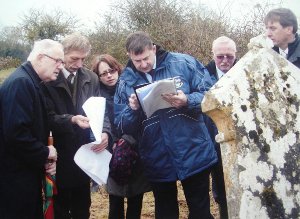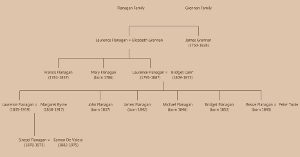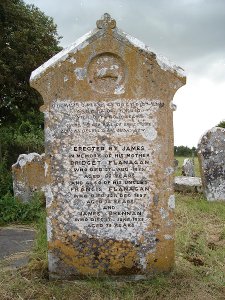Sinead De Valera
and her County Kildare Connections
Published in the Kildare Nationalist, 17th April 2009
The ancestors of Sinead Flanagan wife of Eamon De Valera came from the Carbury area in North West Kildare. Documentary accounts of the Flanagan family in the area survive from the late eighteenth century. The site of two residences can be pinpointed together with an important and historic family memorial in Kilpatrick Graveyard which is situated approximately halfway between Carbury and Allenwood.
The Flanagan family originally came from the townland of Ardkill which is situated about one mile east of Carbury. The earliest record of the family dates from 1786 when a daughter named Mary was born to Laurence Flanagan (the first) and his wife Elizabeth Grennan. It is likely that Elizabeth was connected to the Grennan family of Timahoe who were noted as rebels in 1798 and also in 1803.
In 1795 another sibling Laurence (the second) was born to the Flanagan’s and he married Bridget Cain [Kane] in the early 1830’s. Laurence and Bridget are referred to in Carbury parish Church records simply as Larry and Biddy Flanagan. When their eldest son was born in December 1835 he was also named Laurence (the third). There were at least three other sons in the family, John born in 1837, James in 1842 and Michael in 1846. It is also known that there were two sisters in the family Bessie born in 1840 and Bridget in 1852.
The Griffith Valuation heads of household survey of 1854 show that two families of Flanagan’s lived in Ardkill. Firstly, James Flanagan was the occupier of a substantial holding that was leased from Viscount Harberton the local landlord from at least the late 1700’s. The farm had an area of 221 acres and an additional 91 acres of bog. Secondly, Laurence Flanagan (the second) was the leaseholder of a tenement on the farm described as a house, office and garden with an area of 30 perches. The land was valued at three shillings and the buildings at one pound. It is unknown to what extent, Laurence and James were related. Detail from Church records indicates that they were not brothers. However, the fact that two Flanagan families lived on the one farm would indicate that they were in fact related with the likelihood being that they were either first or second cousins. The site of the original Flanagan house in Ardkill is situated on the Carbury to Enfield road about half a mile west of Carbury Sweep Cross. It is marked by a farmyard known locally as ‘Flanagan’s yard’.
In 1866 Laurence (the second) and his immediate family vacated the tenement in Ardkill and moved to a more valuable property in the townland of Ballyshannon which is now in the village of Derrinturn. The new tenement which was also described as a house, office and land was leased from Robert Boylan. The land had an area of two acres, one rood and was valued at one pound twelve shillings. The buildings were valued at one pound and eight shillings. Laurence worked as a wheel-right in one of his out buildings. Wheel-right-carpentry was a highly skilled trade and very lucrative in the days of horse and cart transport.
Laurence (the third) followed in his father’s footsteps and also became a wheel-right. By 1868 he was living in Balbriggan and working at his trade when he married a local girl Margaret Byrne. The couple shortly afterwards emigrated to the United States. Their daughter Mary was born in New York in 1871. By 1873 the Flanagan’s had returned to Balbriggan where the remainder of the family were born, including Sinead the future wife of Eamon De Valera, who was born on 1 June 1878.
Bridget (nee Cain) Flanagan died aged 66 in 1875 and was buried in the family burial plot in Kilpatrick Graveyard. Kilpatrick is situated about one and a half miles from the Flanagan homestead. Francis Flanagan her brother-in-law was buried in the plot in 1857. However, a generation earlier in 1828, James Grennan her husband’s uncle had been interred in the plot. This points to the likelihood that the burial plot originally belonged to the Grennan family.
Shortly after Bridget’s passing her son James Flanagan erected a substantial memorial on the burial plot, commemorating his mother and uncles. He also included a very interesting and unusual inscription written in Irish on the headstone. It is believed James, worked in the medical profession in London and some of his patents were native Irish speakers. It is from this connection that he developed an interest in and knowledge of the Irish language. The English translation of the inscription is as follows;
‘Honour your Father and donít forget the virtue of your Mother’.
The rime comes from the Apocalypse, the last book of the Bible which is also known as the Book of Revelations. According to the De Valera family the translation on the Flanagan headstone is the first occasion of an Irish translation from the book. The inscription was very unusual as it predates the founding of the Gaelic League by at least fifteen years.
James’s brother Michael was also an individual of note. In his youth he joined the Army and served extensively overseas including India. But it was as a piper that he is most remembered by the family who still have a portion of his original pipes.
In August 1887, when Sinead De Valera was nine years old her grandfather Laurence Flanagan (the second) died. He was aged 92 and was buried in the family burial plot in Kilpatrick. His death certificate indicates that his son-in-law Peter Toole who had married Bessie Flanagan in 1871 was also a resident in the house. Peter at this point took over the leasehold of the property and held it until 1899 when it was acquired by Anne Adams.
The Flanagan connection with the area continued when Sinead obtained her first teaching post in Edenderry about 1900. She lived in Edenderry for a year before acquiring a teaching post in Dublin.
In 1911, Laurence Flanagan (the third) visited Derrinturn accompanied by his son-in-law Eamon De Valera. Laurence travelled in the side car of his son-in-law’s motorbike. They visited the Flanagan homestead which was still owned by the Adams family and also went to the family burial plot in Kilpatrick.

Left to Right: Fr Alphy Murphy, Seamus Cullen, Eimear O’Toole, Éamon Ó’Cuiv TD, Minister for Community, Rural and Gaeltacht Affairs, Martin O’Toole and Councillor Dara Fitzpatrick
Laurence died in Balbriggan eight years later in March 1919 at the age of 83 and was buried locally. He lived through a very important era in Irish History that included three insurrections, a tithe war, a land war and a famine. At the time of his death his son-in-law was the elected political leader of the nation which was in the initial stages of the ‘War of Independence’. It is known that Eamon De Valera subsequently, during his political career visited Kilpatrick on at least two occasions to pay respects to his wife’s ancestors.
At the present time, De Valera – Flanagan relatives continue to take an interest in Kilpatrick. In February 2009, Eamon O’Cuiv a serving Cabinet Minster and grandson of Eamon and Sinead De Valera, visited Kilpatrick graveyard. The visit which was at the invitation of Michael Fitzpatrick TD was an important local heritage event. The Minister was welcomed by the Kilpatrick Burial-ground Association and many well-wishers. On the occasion he was given details of his grandmother’s connection to the area and laid a wreath on the Flanagan grave where his Kildare ancestors are buried.


